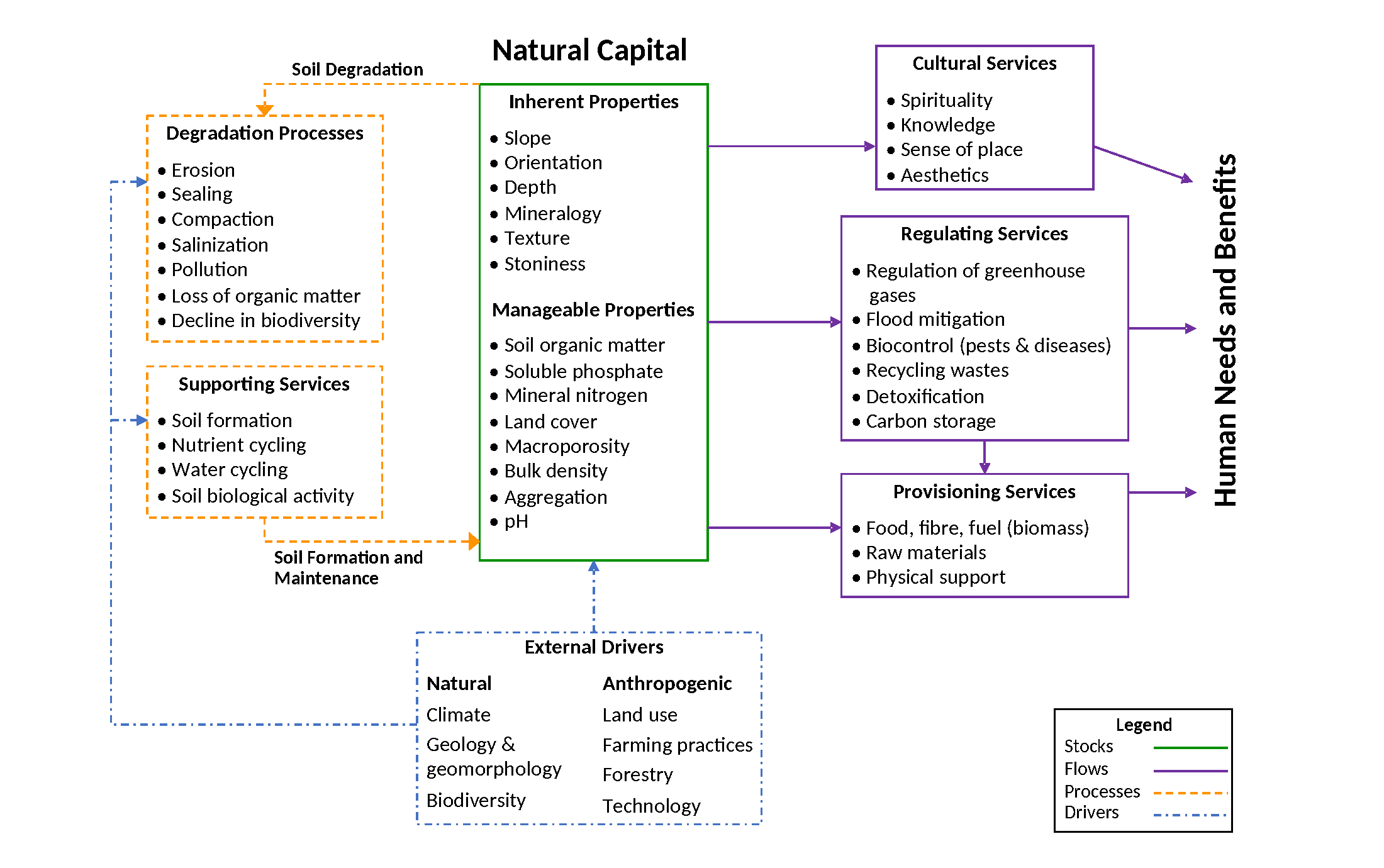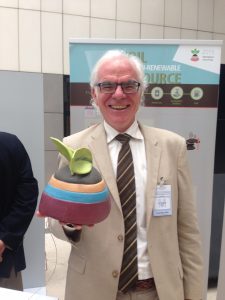Digging In
1 Introduction
Fran Walley; Maja Krzic; Amanda Diochon; Maxime C. Paré; and Rich Farrell
LEARNING OUTCOMES
On completion of this chapter, you will be able to:
- Define soil as a physical entity
- List and describe the four major categories of ecosystem services
- Explain how soil and soil processes contribute to ecosystem services
- Describe soil as natural capital and describe how natural capital may increase or decrease
THE SOIL BENEATH OUR FEET
Embarking on a study of soil starts with the contrasts that soils present. Soil is as common as the dirt beneath our feet. It sticks to our boots and tracks into our homes. We curse it when we get a vehicle stuck in the mud, or when it ruins a pair of shoes. Parents may be distraught when their child tastes a scoop of it. We are horrified when disaster strikes and a mudslide destroys everything in its path. Yet, soil also is the foundation to terrestrial life as we know it, and is amazingly complex and surprisingly rich with life. Soil impacts virtually every aspect of our lives. It provides a medium for production of food, fibre and bioproducts from energy biomass to fancy cosmetic products. It provides the physical foundation for buildings and roads. Since the very beginning of human civilization, soil has provided materials for our artistic expressions through paintings, sculptures and pottery. During antiquity, the Greek philosophers Empedocles and Aristotle recognized soil among the four main elements (i.e., “earth”, air, fire and water) used to explain the nature and complexity of all matter. Intrinsically linked to the global ecosystem, soil impacts and regulates climate, both emitting and sequestering greenhouse gases. Hydrological cycles are regulated by soil at local to global scales. Soil is a vast reservoir of biological diversity, replete with complex habitats. From this biodiversity, humankind has discovered and harnessed invaluable products including lifesaving antibiotics, microbial agents for the biocontrol of pests and plant diseases, and organisms capable of remediating polluted and contaminated areas. Soil has been recognized as the final frontier for human exploration (see Soils – the Final Frontier, 2004, Science, Vol. 304, Issue 5677), and holds the promise of untapped biological resources yet to be discovered. Did you know that when NASA lands on another planet or an asteroid they collect surface materials to search for evidence of life? We are connected to soil, physically, psychologically and spiritually. We know the soil of our homelands by sight and feel and smell, and we long to reconnect and to stay connected. Soil – humble and mighty, and right there, beneath our feet.
So how does one start the journey of discovering soil in all its many known facets? In this textbook, we introduce soils through the various sub-disciplines in which soil scientists have traditionally organized themselves. You will be introduced to soil genesis, soil organic matter, soil physics, soil chemistry, and you also will learn the inherent linkages between these areas when you delve into soil biodiversity and ecology, soil nutrient cycling and soil classification. You will travel virtually across Canada and learn about the dominant soil types and processes, and begin to further explore advances in digital soil mapping, soil micromorphology, and the importance of soil health and soil reclamation and remediation. We hope that as you study, you also will take the time to read about the Canadian soil scientists who have authored chapters in this textbook and hear about their journey as soil scientists – perhaps one of them is your instructor.
WHAT IS SOIL?
Defining soil is a bit tricky, largely because the definition may depend on your particular perspective. A farmer may view soil as the medium that supports plant growth, whereas an engineer may view it as the medium on which construction takes place—a foundation for roads or buildings, for example. These and other definitions of soil are further complicated by the complexity of soil itself. Soils are highly varied, at local, regional and global scales, so arriving at a single definition that applies equally to all soils is challenging indeed. The Canadian Society of Soil Science provides two definitions of soil (Gregorich et al., 2002):
- The unconsolidated mineral or organic material on the immediate surface of the Earth that serves as a natural medium for the growth of land plants.
- The natural, unconsolidated mineral or organic matter on the surface of the Earth that has been influenced by parent material, climate, macro- and micro-organisms, and relief, all acting over a period of time to produce a material different from which it was derived in many physical, chemical, biological, morphological properties.
These definitions tell us a lot about soil . . . it is a natural substance and a living medium that may contain both mineral and organic materials and, uniquely, it is found at the uppermost surface of planet Earth. Martian soil, therefore, is not considered in this definition! The word “natural” also figures prominently, and the reference to macro- and micro-organisms tells us that soil is alive, and the living soil supports the growth of living plants and organisms. Indeed, without living organisms, soil ceases to function as a biological entity, and ultimately, could not support life on our planet. These definitions also reveal that soils have a “parent” and the parent materials ultimately contribute to the unconsolidated mineral or organic material that transforms into soil over time. Perhaps then, we need to know more about the parent material. We know our own parents have influenced our genetic make-up. Just as you may have blue eyes and curly hair like your mother and are tall like your father, soils also have characteristics akin to their parent material. These definitions also reveal that soil is a dynamic entity, ever changing and ever changed by the external environment. Indeed, humans have had, and continue to have, an enormous impact on soil, but it is important to note that soil continues to change with or without human action, and even the passage of time alone can bring about changes in a soil.
SOIL AND ECOSYSTEM SERVICES
Beyond defining soil as a physical entity as described above, soil also can be defined based on the ecosystem services it provides and supports. Ecosystem services are the benefits that humans derive directly and indirectly from ecosystems. Although the notion of ecosystem services has long been recognized by scientists, particularly those working in the area of sustainability science, the concept was formalized in a report of the Millennium Ecosystem Assessment (MEA) (MEA, 2005), an initiative conducted under the auspices of the United Nations, and called for by then Secretary-General Kofi Annan in 2000. The MEA report defined an ecosystem as “a dynamic complex of plant, animal and microorganism communities and the nonliving environment interacting as a functional unit” (2005, p. ν). The report grouped ecosystem services into four main categories: (1) provisioning services; (2) regulating services; (3) supporting services; and (4) cultural services. Soils provide and contribute to many functions within ecosystems, and humans derive many benefits from soil, both directly and indirectly (Figure 1.1), all of which fall within one or more of these four main categories.
Provisioning services of soil are perhaps the easiest to recognize. Our relationship with soil is very direct: we grow more than 95% of our food, animal feed, fibre and, in some instances, our fuel in soil. Soils provide these goods and play a crucial role in ecosystem functioning (Adhikari and Hartemink, 2016). The sustained provision, or flow, of these goods or products from soil is dependent on the health of the soil and its ability to support plant growth now and for future generations. It follows that provisioning services are dependent both on the intrinsic chemical, physical, and biological properties of the soil as well as those properties that can be managed to improve or sustain the productivity of the soil (Dominati et al., 2010). Equally, soil degradation processes, such as soil erosion or soil salinization, can reduce soil quality and hence it’s capacity for provisioning services.
The regulating services that soils provide are many and easily overlooked. For example, we know that the levels of atmospheric carbon dioxide, an important greenhouse gas, are increasing. Soils can sequester, or retain, carbon from the atmosphere. Specifically, through the process of photosynthesis atmospheric carbon dioxide is transformed, or “fixed”, by plants into simple carbon molecules that are incorporated into structures within the plant. A similar transformation occurs within photosynthetically active soil microorganisms. These organic components, when returned to the soil, contribute to the soil organic matter thereby “sequestering” carbon that originated in the atmosphere as carbon dioxide. When this occurs the soil is effectively a sink for carbon but when this same organic matter decomposes soils also can be a source of carbon either as carbon dioxide or methane. The degree to which soils act as either a sink or source of these greenhouse gases can be controlled, to some degree, by appropriate management strategies such as minimum tillage practices. Similarly, the degree to which soils emit nitrous oxide, another very powerful greenhouse gas, is directly dependent on soil mineral nitrogen in the soil, which is a a manageable soil property in agroecosystems. Other regulating services provided by soils include water management and flood mitigation, biological control of pests and diseases, and detoxification of unwanted substances, to name a few. These examples of the regulating services that soils provide are not exhaustive, and other soil functions occurring at both the micro and macro scales—some of which have yet to be explicitly identified—are likely to fall within the category of regulating services.

Cultural services include the many non-material benefits derived from soils, such as spiritual enrichment, knowledge, sense of place, and connection to the land that soils provide. Many people and communities feel a deep connection to the land and the soil of their homeland. Clearly soil and the notion of soil matters at many levels. For many, the soil of their homeland represents them and who they are as a people—its colour or its smell after a rain, for example, reminds them of home and provides a sense of place.
Finally, supporting services provide support for the production of all other ecosystem services. Soil formation is an example of a supporting service that ultimately must take place to support all other ecosystems services. Other examples of supporting services include nutrient cycling, water cycling and soil biological activity, without which the other ecosystem services would not be achievable.
SOIL AS NATURAL CAPITAL – STOCKS AND FLOWS
The degree to which any individual soil contributes to the four categories of ecosystem services is dependent on inherent properties of the soil, and the degree to which these properties are expressed in a particular environment. For example, it is easy to recognize the provisioning services of soil—our food, feed, fibre, biomass and wood all grow in soil—but do all soils contribute equally to provisioning services? The answer, of course, is no. Some soils are inherently more fertile and thereby capable of providing greater crop yields, or are more capable of provisioning growth of forests for lumber production, or growth of biomass for use in energy production. Indeed, there are measurable chemical, physical and biological properties of soil that contribute to the ability of a soil to provide the different types of ecosystem services. In this sense, we can view soils through an economic lens and link the provision of ecosystem services to the perceived worth of a particular soil.
Linking the ecosystem services to economic concepts has led to the suggestion that soil can be viewed as natural capital or stock from which ecosystem services and useful goods flow (Dominati et al., 2010) (Figure 1.2). It follows that if the natural capital can grow, it also can be depleted. Moreover, certain soil properties contribute directly to the natural capital and either are inherently present and largely unchangeable or are changeable only very slowly (e.g., soil texture, presence or absence of stones, orientation and slope, etc.), or can be managed directly to enhance the natural capital. For example, organic matter is known to contribute significantly to the productivity potential of soil (i.e., its natural capital), and farmers can use minimum tillage and other management practices to enhance soil organic matter levels, thereby increasing the natural capital of the soil. Conversely, excessive tillage can lead to soil degradation and loss of soil organic matter, thereby reducing the natural capital of the soil.

Identifying and understanding inherent and manageable soil properties allows us to understand what ecosystem services a given soil can provide, and ultimately the magnitude of the flows of these services. External drivers such as climate change that can affect soil development and stability or anthropogenic drivers such as land use including soil “sealing” (i.e., urban sprawl or highways that seal the soil from other potential uses), farming practices, forestry, and other human activities that directly impact soils, all influence the soil’s natural capital; thus it is essential that we understand how these drivers can affect soil sustainability. The natural capital of soil is well worth preserving to ensure the sustainable flow of ecosystem services, and to meet human needs now and in the future.
In the following chapters, you will learn about the various physical, chemical and biological properties of soil, and the many interactions that occur between these properties that ultimately influence soil processes within ecosystems. As you learn more about the various soil properties in the following chapters, you will recognize that specific soil properties contribute to specific soil functions. Ultimately, identifying and understanding this connection can help us determine how best to manage soils to protect and sustain the desired functions from which humans derive enormous benefits. Our lives—and our livelihoods—depend on it!
BEYOND THE SCIENCE
As you read this textbook, and learn more about soils, you also will meet the soil scientists who have contributed to the creation of this book. You will learn about the many professions in which they work, as well as the vast fields of research to which they contribute. You also will learn that soil science is a passion for many, and that this passion goes far beyond the science and represents a lifelong journey of discovery and wonder for the most humble, and yet enormously complex ecosystem—soil.
A passion for soil has led to many descriptions of soil in the literature, including this from L.H. Bailey’s introduction to a very early but surprisingly relevant introductory soil science textbook published in 1909 “The Principles of Soil Management” (The MacMillam Company, Pennsylvania) (p. xxix-xxx):
“This marvelously thin layer of a few inches or a very few feet that the farmer knows as “the soil,” supports all plants and all [humankind], and makes it possible for the globe to sustain a highly developed life. Beyond all calculation and all comprehension are the powers and the mysteries of this soft outer covering of the earth. We do not know that any vital forces pulsate from the great interior bulk of the earth. For all we know, the stupendous mass of materials of which the planet is composed is wholly dead; and only on the veriest surface does any nerve of life quicken it into a living sphere. And yet, from this attenuated layer have come numberless generations of giants of forests and of beasts, perhaps greater in their combined bulk than all the soils from which they have come; and back into this soil they go, until the great life principle catches up their disorganized units and builds them again into beings as complex as themselves.”
Can You Dig It!

Did you know that the United Nations supports and promotes healthy soils?
The Food and Agriculture Organization (FAO) of the United Nations has a long history of promoting healthy soils as a basic prerequisite for the provision of essential ecosystem services, particularly as it relates to the global provision of food, fiber, fodder and other essential products. Indeed, the first World Soil Charter was introduced in 1981 at an FAO conference, and was heralded as a policy instrument to provide guidance to governments around the world for the management of soils—with a particular goal of addressing land degradation, which was identified as a major constraint to expanding agricultural production. More recently, the United Nations declared 2015 the International Year of Soils and endorsed a Revised World Soil Charter, which is widely available on-line (search World Soil Charter). The Revised World Soil Charter has an expanded goal of addressing new and emerging issues, such as soil pollution, climate change and urban sprawl. So what is the connection to the Canadian Society of Soil Science? Importantly, Canada is a member country of the United Nations, and has a Canadian representative on its scientific advisory committee, the Intergovernmental Technical Panel on Soils. In 2015, the Canadian representative was Dr. Dan Pennock, a Fellow of the Canadian Society of Soil of Science and a primary author of the 2015 Revised World Soil Charter. The charter outlines principles and guidelines for action by a range of international stakeholders to fight against soil degradation and to encourage sustainable soil management. Clearly, Canadian soil scientists are having a global impact!
THOUGHT EXERCISES
- From your perspective (university student, farmer, future agronomist, global citizen, environmentalist, engineer, etc.), and in the context of ecosystem services, what is soil?
- In addition to the soil functions listed in Figure 1.1, what are some other examples of functions that soils provide?
REFERENCES
Adhikari, K. and A.E. Hartemink. 2016. Linking soils to ecosystem services – A global review. Geoderma 262:101-111.
Bailey, L.H. 1909. Introduction. In L.H. Bailey (Ed.), The principles of soil management, The rural textbook series (pp. xxix-xxx). The MacMillan Company of Canada, Ltd., Toronto. 531 pp.
Dominati, E., M. Patterson and A. Mackay. 2010. A framework for classifying and quantifying the natural capital and ecosystem services of soils. Ecological Economics 69:1858-1868.
Gregorich, E.G., L.W. Turchenek, M.R. Carter, and D.A. Angers. 2002. Soil and Environmental Science Dictionary. CRC Press, Boca Raton, FL. 577 pp.
Millennium Ecosystem Assessment. 2005. Ecosystems and human well-being: Synthesis. Washington, DC: Island Press.
About the Authors
Fran Walley, Professor, Soil Science, College of Agriculture and Bioresources, University of Saskatchewan.

After taking an introductory Soil Science course during my early university years, I worked as a summer assistant in the Department of Soil Science, University of Manitoba. I knew then that I had found my passion. It seemed to me then, as it does now, that soil science brought together everything that I loved. I love being outdoors, and soils research is all about being outside and in nature. I also love biology and understanding how the natural environment works. To me, soil science is applied biology, and I love to apply my knowledge of biology to soils. Over the years, soil science also has allowed me to grow as an environmentalist and contribute to sustaining our precious environment. What’s not to love?
*
Maja Krzic, Associate Professor, Faculty of Land and Food Systems / Faculty of Forestry, University of British Columbia, Vancouver

Growing up in Belgrade, former Yugoslavia (now Serbia), the only plants that I could encounter were those in parks and in pots at balconies of apartment buildings where we lived. Nevertheless, I was always intrigued with plants and decided to study agronomy to learn about them and their role in food production. I did not even know that there is such a discipline as soil science until I took a pedology course in the 2nd year of university and I was hooked! Being a soil scientist allowed me to work in a variety of ecosystems ranging from agricultural crop settings to grasslands, forests, urban brownfields and even golf courses in several countries around the world. However, the most rewarding part of my career are interactions with students and helping them learn about soil and its importance.
*
Amanda Diochon, Associate Professor, Department of Geology, Lakehead University, Thunder Bay

When I was little you could often find me getting my hands dirty making mud-balls for a neighborhood mud battle, mud-stew for our imaginary village, and digging holes to reveal buried treasures. My very first independent science experiment was in middle school when I tested the effects of soil pH and nutrients on plant growth for the science fair. It’s a classic and I even placed! I still get to do all those things but with a different purpose and perspective. Now I get to make “soil balls” when discussing soil texture, “soil shakes” to measure changes in dissolved organic carbon in response to disturbances like forest harvesting and fire, and dig soil pits to expose the beautiful horizons beneath our feet and reveal the stories that the soil can tell us about its past, present and potential future. I may be older but I approach the soil with the same passion, wonder and excitement as that little girl. Perhaps you will too!
Maxime C. Paré, Professor, Université du Québec à Chicoutimi

I became interested in soil science at the same time that I became involved in agriculture: as a child. I grew up in a small French-Irish town in Quebec (Saint-Ambroise-de-Kildare), and many of my friends’ dads were dairy farmers. While helping them out during the haymaking season, I remember asking myself questions about basic yet important observations, such as, Why do some fields yield more and produce better quality hay than others? Soil pedogenesis and differences in soil quality quickly came to mind! Later, soil science became even more important during my undergraduate years at Université Laval (Quebec City). My first job as an undergraduate research assistant was working for Dr Léon-Étienne Parent, who undoubtedly propelled my interest for the discipline into the stratosphere! At that time, Professor Parent had numerous fertilization trials spread throughout the province, involving a multitude of crops. What I suspected as a child suddenly became real science; namely, these things were measurable, quantifiable, and replicable! Very exciting, no? Still now, every time I read a book or I review a paper, I learn something new about this discipline. This constant learning makes me revisit those feelings and questions I had as a young boy and keep the soil science fire burning inside me. Knowledge is my fuel and this book is a great opportunity to pass on the flame to the next generation!
*
Rich Farrell, Associate Professor, Department of Soil Science, University of Saskatchewan

I am a native Rhode Islander and though I grew up in the suburbs, I have been interested in soil science since I was 13 when a friend of mine jokingly suggested doing a science project on soils because “there’s nothing alive in soils” . . . . oh, was he wrong! So, I did my project on “Soils and Soil Conservation”, and managed to win 2nd prize in the local science fair—though one of the judges said that the study of soils wasn’t real science . . . . oh, was he wrong! So, here I am many years later still studying what I love. My research focus is on environmental agronomy—including the effects of agricultural practices on soil quality and greenhouse gas production/mitigation in agroecosystems. I am also co-director of the Prairie Environmental Agronomy Laboratory (PEARL), which supports research aimed at developing strategies that enhance or maintain agro-ecosystem capacity and integrity and establish the low GHG footprint of prairie cropping systems.
The tangible and intangible benefits humans gain from ecosystems (e.g., food, waste assimilation, aesthetic, nutrient cycling).
The process by which water-soluble salts accumulate in the soil. Salinization may occur naturally or because of conditions resulting from management practices, and is of concern because excess salts hinder the growth of crops by limiting their ability to take up water.

